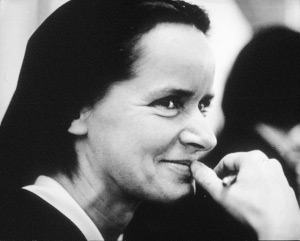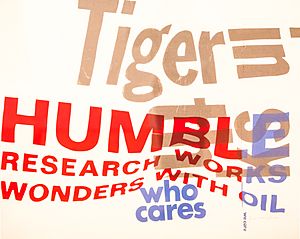Corita Kent facts for kids
Quick facts for kids
Corita Kent
|
|
|---|---|
 |
|
| Born |
Frances Elizabeth Kent
November 20, 1918 Fort Dodge, Iowa, US
|
| Died | September 18, 1986 (aged 67) Boston, Massachusetts, US
|
| Known for | Silkscreen, serigraphy |
| Movement | Pop art |
Corita Kent (born Frances Elizabeth Kent, November 20, 1918 – September 18, 1986) was an American artist, designer, and teacher. She was also known as Sister Mary Corita Kent because she was a religious sister for many years. Her artwork often focused on important ideas like Christianity and social justice, which means fairness for everyone. She also taught art at Immaculate Heart College in Los Angeles.
Corita's main way of making art was through screen printing, also called serigraphy. She learned this by herself using a kit. Her art was special because it used bright colors, bold words, and images from everyday life, like grocery store signs. She wanted her art to be affordable for everyone, so her messages of love and peace could reach many people. Her work became very popular during the 1960s and 1970s, a time when many people were working for social change.
After leaving her religious order, Corita moved to the East Coast. Even after being diagnosed with cancer in the early 1970s, she created many famous works. These include the Rainbow Swash design on a large gas tank in Boston and the 1985 "Love" stamp for the United States Postal Service. In recent years, more people have recognized Corita Kent's important role in the pop art movement. Her art was a way for her to share her beliefs and promote love and understanding in the world.
Contents
Corita's Life Story
Growing Up and Becoming an Artist
Frances Elizabeth Kent was born in Fort Dodge, Iowa, in 1918. She was the fifth child in her family. Her parents, especially her father, loved art and always encouraged her to be creative. When she was in junior high, some nuns at her school noticed her artistic talent.
After graduating from high school in 1936, Frances joined a group of Catholic sisters called the Sisters of the Immaculate Heart of Mary in Los Angeles. She took the name Sister Mary Corita. This group was known for being open to new ideas and encouraging creativity. Corita studied art at several colleges, including Otis College of Art and Design and Chouinard Art Institute. She earned her bachelor's degree from Immaculate Heart College in 1941 and her master's degree in art history from the University of Southern California in 1951.
Teaching and Creating Art
From 1938 to 1968, Corita lived and worked with the Immaculate Heart Community. She taught at Immaculate Heart College and became the head of its art department in 1964. Her art classes were very special and attracted famous artists and thinkers like Alfred Hitchcock and Buckminster Fuller. Corita's teaching methods were unique; for example, she might ask students to draw their arm for three hours without looking at it!
Corita's art became more focused on social issues in the 1960s. She created art about topics like the Vietnam War and helping people in need. For example, she made billboards that said "we can create life without war." Her art also helped with a movement to update the Catholic Church, making things like Mass easier to understand by using English.
Because her art was so strong and political, there were some disagreements with church leaders. To avoid problems, Corita decided to leave her religious order in 1968 and became known as Corita Kent. Many other sisters also left the order, and Immaculate Heart College eventually closed in 1980. Corita continued to support important movements like the anti-Vietnam War movement, Civil Rights, and Women's Rights.
Corita created hundreds of screen prints for posters, book covers, and murals. Her famous works include the 1985 "Love" stamp for the United States Postal Service, which sold over 700 million copies! She also created the Rainbow Swash in 1971, which is a huge design on a gas tank in Boston. It's one of the largest copyrighted artworks in the world.
Her art has been shown in many places since 1952. By the 1960s, her work was in collections at famous museums like the Los Angeles County Museum of Art, the Museum of Modern Art, and the Metropolitan Museum of Art.
Later Life and Passing
Corita Kent was diagnosed with ovarian cancer in 1974. Even while fighting cancer, she continued to create art, focusing on watercolor paintings. She passed away on September 18, 1986, at the age of sixty-seven. She left her artworks and copyrights to the Immaculate Heart Community, which was formed by the former sisters in Los Angeles.
Corita's Artistic Style
Corita Kent's art mixed different ideas from culture, politics, and religion. She was inspired by artists like Andy Warhol and started using images from popular culture in her work around 1962. Her screen prints often combined well-known product brands with spiritual messages. She would take an original advertisement, maybe tear or crumple it, and then re-photograph it to create her unique designs. She also used grocery store signs, parts of the Bible, newspaper clippings, song lyrics, and writings from famous authors like E. E. Cummings.
E. E. Cummings was a big influence on Corita. She used his quotes many times in her art. She also used everyday items, like the Wonderbread logo, to connect her religious thoughts to things people saw every day. By putting "high art" next to everyday objects, she showed that beauty and holiness could be found everywhere. Her friend, theologian Harvey Cox, said she could make ordinary things "a vehicle of the luminous, the only, and the hope filled."
Corita's early art was often based on religious images and texts. Her style used a lot of text, with Bible passages or positive quotes filling her artworks in bold, bright letters. Even though her art sometimes looked a bit wild or confusing, it was "always about something." In the 1960s, her art became more political. For example, her screen print stop the bombing (1967) was a large piece protesting nuclear weapons, using bold blue letters against a white and red background.
Corita's art was a response to changes in the Catholic Church in the 1960s and to many social and political issues happening at the time. Her art helped the Vatican II movement, which aimed to make the Catholic Church more modern. For instance, her use of English church texts in her art helped encourage the idea of having Mass in English.
She used the "Big G" logo from General Mills to talk about "goodness." She also used elements from Esso gasoline ads to represent the inner strength of people. Many of her artworks had a Christian message, but not all of them, leaving room for different interpretations.
One of Corita’s prints, love your brother (1969), shows pictures of Martin Luther King Jr. with her handwritten words, "The king is dead. Love your brother." This was a serious artwork that showed her views on politics and human nature. Her collages often took popular images and twisted words to comment on the political unrest of the time. Many of these artworks could have been seen at marches or protests, some of which she attended herself.
Corita's Legacy
Corita Kent's art is displayed in many art museums, including the Whitney Museum of American Art, the Museum of Fine Arts, Boston, and The Metropolitan Museum of Art. There is a special place called the Corita Art Center in Hollywood, California, that keeps her artworks and papers. Some of her early works are also at Harvard University.
The Corita Art Center was started in 1969 to keep Corita Kent's work and spirit alive. It is located at the Immaculate Heart Community Headquarters.
Corita Kent received the American Institute of Graphic Arts Medal in 2016, which is a big award for graphic designers.
Awards and Recognition
- 1966: Named Woman of the Year by the LA Times
- 1967: Featured on the cover of Newsweek magazine
- 2016: Awarded the American Institute of Graphic Arts Medal
Books by or about Corita Kent (Partial List)
- 1967: Footnotes and Headlines: A Play-Pray Book, by Sister Corita
- 1968: To Believe in God, a poem by Joseph Pintauro, with colors by Sister Corita
- 1969: city, uncity, poems by Gerald Huckaby, with pages by Corita Kent
- 1992: Learning By Heart: Teachings to Free the Creative Spirit, by Corita Kent (published after she passed away) and Jan Steward
- 2006: Come Alive! The Spirited Art of Sister Corita, by Julie Ault
Stage Plays
- 2023: Little Heart - The story of Corita Kent, by Irene O'Garden
See also
 In Spanish: Corita Kent para niños
In Spanish: Corita Kent para niños


